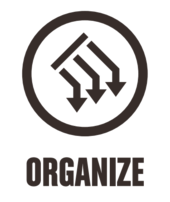Step 3: Organize
Oops! You forgot again. Didn’t you? 
You were supposed to pick up a dozen eggs from the mega mart and it is plumb on the way home. Now you are backing up into your parking spot and cursing yourself at the same time.
To add insult to injury, you didn’t even get your tires checked. Because you were talking to your wife on the phone who told you…you guessed it right, to buy a dozen eggs.
For most of us, our busy lives are difficult labyrinths of ‘to-dos’ to navigate.
It doesn’t really matter who you are and what you do. If you are living in the 21st century with a smart phone and an email account full of impatient ‘open me’ messages, you can do with some thoughtful organization of your agreements and next actions.
The third step of GTD shows how you can organize your next actions, so that you can remember to do the right things at the right time.
What is Organize?
Once you’ve clarified what your Next Action is, ‘Organize; is putting the Next Actions in their appropriate categories
Your Next Actions should be compartmentalized by context so that one activity can’t trespass on the time and place of another.
How to Organize?
GTD suggests creating at least 7 context specific sub-lists which start acting as mini-maps to optimize your productivity in a particular setting.
- Calls – This list keeps track of all the phone calls that need to be made. It should be on your person because these days a mobile phone is ubiquitous and a long wait in a queue can be the ideal window of time to wrap some urgent conversations up.
- At Computer – This list should be near your computer station. Whenever you have access to your machine, you should automatically start checking items off.
- At Office – This list belongs in your cubicle. It is a complication of the tasks you have to complete at ‘work’ where it is both easy and logical to do them.
- At Home – The name says it all. The list should allow you to easily remember the next actions associated with the agreements made in relation to the home turf.
- Errands – A list that nudges you to get ‘to-dos’ done when you are out and about.
- Agendas – This list keeps you on track where real time interactions with other people are concerned. It is the most dynamic of all contexts because meetings are often finalized ad-hoc and you need to have uninterrupted access to your ‘Agendas’ task pool to update it accordingly. You can in fact have an Agenda List for all the key people in your life. One for your wife, one for ‘the boss’, one for your little ones and so on.
Best Practice for Organize:
– Organize your Next Actions in clear categories. Refer to the examples above.
Worst Practice for Organize:
– Putting your Next Actions in blended ‘huh’ stacks. Putting all your next actions in one generic to-do list.
What are my next steps?
- Organize your Next actions in their appropriate context
